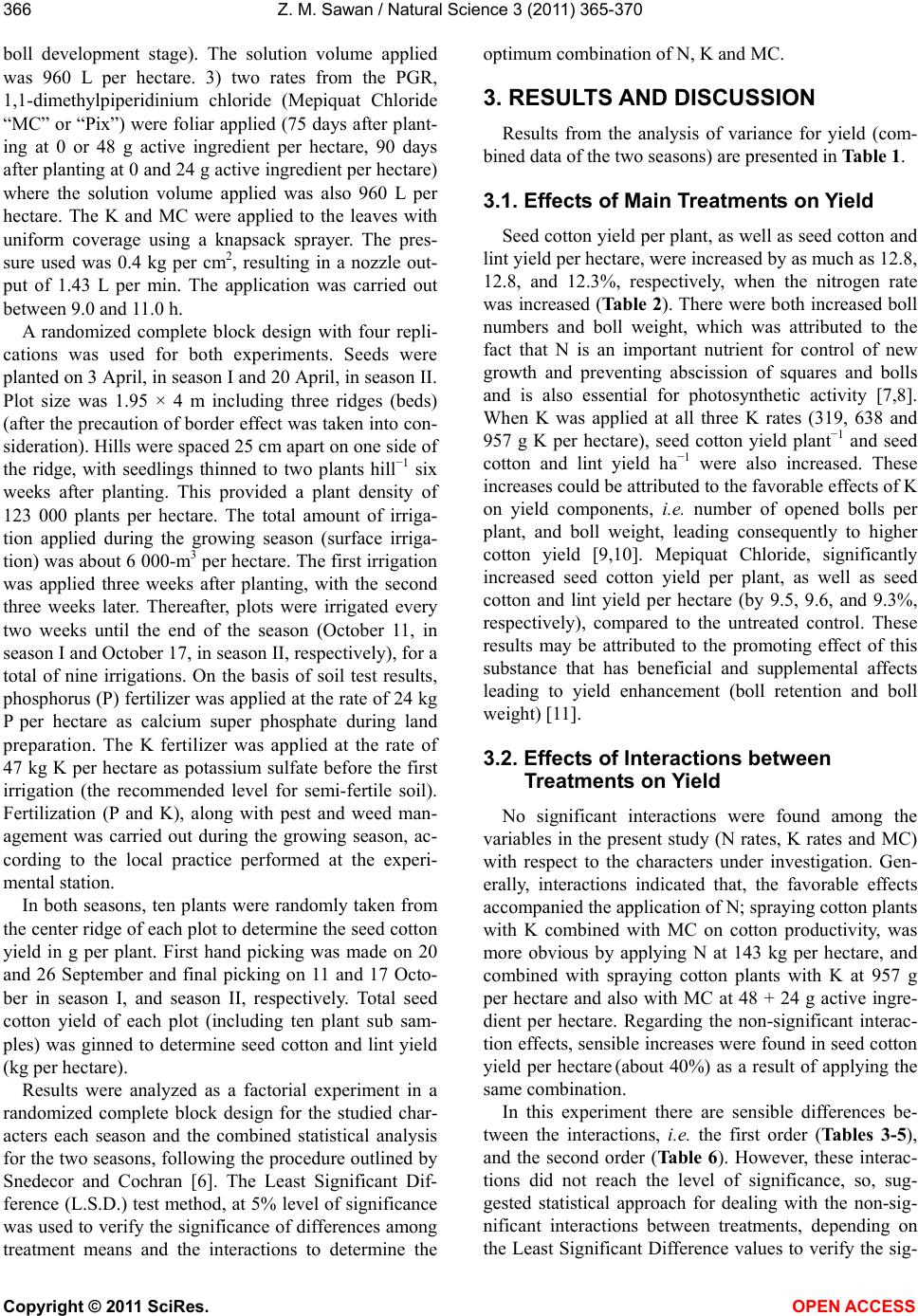
Z. M. Sawan / Natural Science 3 (2011) 365-370
Copyright © 2011 SciRes. OPEN ACCESS
366
boll development stage). The solution volume applied
was 960 L per hectare. 3) two rates from the PGR,
1,1-dimethylpiperidinium chloride (Mepiquat Chloride
“MC” or “Pix”) were foliar applied (75 days after plant-
ing at 0 or 48 g active ingredient per hectare, 90 days
after planting at 0 and 24 g active ingredient per hectare)
where the solution volume applied was also 960 L per
hectare. The K and MC were applied to the leaves with
uniform coverage using a knapsack sprayer. The pres-
sure used was 0.4 kg per cm2, resulting in a nozzle out-
put of 1.43 L per min. The application was carried out
between 9.0 and 11.0 h.
A randomized complete block design with four repli-
cations was used for both experiments. Seeds were
planted on 3 April, in season I and 20 April, in season II.
Plot size was 1.95 × 4 m including three ridges (beds)
(after the precaution of border effect was taken into con-
sideration). Hills were spaced 25 cm apart on one side of
the ridge, with seedlings thinned to two plants hill−1 six
weeks after planting. This provided a plant density of
123 000 plants per hectare. The total amount of irriga-
tion applied during the growing season (surface irriga-
tion) was about 6 000-m3 per hectare. The first irrigation
was applied three weeks after planting, with the second
three weeks later. Thereafter, plots were irrigated every
two weeks until the end of the season (October 11, in
season I and October 17, in season II, respectively), for a
total of nine irrigations. On the basis of soil test results,
phosphorus (P) fertilizer was applied at the rate of 24 kg
P per hectare as calcium super phosphate during land
preparation. The K fertilizer was applied at the rate of
47 kg K per hectare as potassium sulfate before the first
irrigation (the recommended level for semi-fertile soil).
Fertilization (P and K), along with pest and weed man-
agement was carried out during the growing season, ac-
cording to the local practice performed at the experi-
mental station.
In both seasons, ten plants were randomly taken from
the center ridge of each plot to determine the seed cotton
yield in g per plant. First hand picking was made on 20
and 26 September and final picking on 11 and 17 Octo-
ber in season I, and season II, respectively. Total seed
cotton yield of each plot (including ten plant sub sam-
ples) was ginned to determine seed cotton and lint yield
(kg per hectare).
Results were analyzed as a factorial experiment in a
randomized complete block design for the studied char-
acters each season and the combined statistical analysis
for the two seasons, following the procedure outlined by
Snedecor and Cochran [6]. The Least Significant Dif-
ference (L.S.D.) test method, at 5% level of significance
was used to verify the significance of differences among
treatment means and the interactions to determine the
optimum combination of N, K and MC.
3. RESULTS AND DISCUSSION
Results from the analysis of variance for yield (com-
bined data of the two seasons) are presented in Table 1.
3.1. Effects of Main Treatments on Yield
Seed cotton yield per plant, as well as seed cotton and
lint yield per hectare, were increased by as much as 12.8,
12.8, and 12.3%, respectively, when the nitrogen rate
was increased (Table 2). There were both increased boll
numbers and boll weight, which was attributed to the
fact that N is an important nutrient for control of new
growth and preventing abscission of squares and bolls
and is also essential for photosynthetic activity [7,8].
When K was applied at all three K rates (319, 638 and
957 g K per hectare), seed cotton yield plant−1 and seed
cotton and lint yield ha−1 were also increased. These
increases could be attributed to the favorable effects of K
on yield components, i.e. number of opened bolls per
plant, and boll weight, leading consequently to higher
cotton yield [9,10]. Mepiquat Chloride, significantly
increased seed cotton yield per plant, as well as seed
cotton and lint yield per hectare (by 9.5, 9.6, and 9.3%,
respectively), compared to the untreated control. These
results may be attributed to the promoting effect of this
substance that has beneficial and supplemental affects
leading to yield enhancement (boll retention and boll
weight) [11].
3.2. Effects of Interactions between
Treatments on Yield
No significant interactions were found among the
variables in the present study (N rates, K rates and MC)
with respect to the characters under investigation. Gen-
erally, interactions indicated that, the favorable effects
accompanied the application of N; spraying cotton plants
with K combined with MC on cotton productivity, was
more obvious by applying N at 143 kg per hectare, and
combined with spraying cotton plants with K at 957 g
per hectare and also with MC at 48 + 24 g active ingre-
dient per hectare. Regarding the non-significant interac-
tion effects, sensible increases were found in seed cotton
yield per hectare (about 40%) as a result of applying the
same combination.
In this experiment there are sensible differences be-
tween the interactions, i.e. the first order (Tables 3-5),
and the second order (Table 6). However, these interac-
tions did not reach the level of significance, so, sug-
gested statistical approach for dealing with the non-sig-
nificant interactions between treatments, depending on
the Least Significant Difference values to verify the sig-